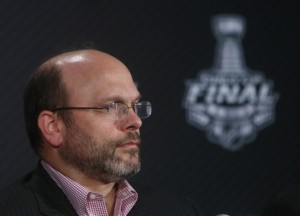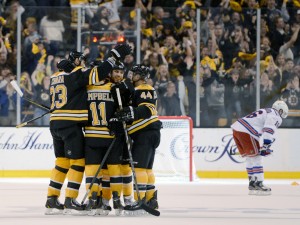The NHL Trade Deadline is a weird time.

For the next week, endless rumors and speculation will come across all channels about teams looking to improve or sell off their team and players who could be on the move. The majority of the speculation rarely comes to fruition, and the Trade Deadline Day itself ends up being less than spectacular with networks devoting all-day coverage to pick apart trades like Matthew Lombardi for Brandon McMillan or the 2012 major blockbuster of Tom Gilbert for Nick Schultz.
It’s gotten bad in the last few years because the trade market has become more competitive than ever. Teams are overrating players, demanding ludicrous returns for mere rentals, scaring other general managers into staying put and trusting their roster going into the final part of the NHL season. Maybe it used to be exciting, or maybe it was always the idea of the Trade Deadline Day. For some teams, it could be that one day where the season turns around. Think about it: a fringe team on the edge of playoff contention adding that one game-changing player that becomes the difference-maker. That one small shake-up that turns a team into a contender from a pretender. That one extra jolt of energy that changes the landscape of the locker room and the overall identity of the team.
Yeah, that doesn’t really happen often anymore.
Last season sort of proved that. The biggest difference-makers to a team’s success are usually the trades that flew under the radar. Last season’s Chicago Blackhawks added Michal Handzus, who played an important role in the team’s championship run, but was in no way a major acquisition–he cost a 2013 4th round draft pick. The Pittsburgh Penguins, St. Louis Blues, and New York Rangers all made major moves for big-name players, none of which played in the Stanley Cup Final.
And then there’s the Boston Bruins.
The Bruins’ recent history around the Trade Deadline has been interesting. Last season, when they were rumored to be heavy favorites to land Jarome Iginla, they instead acquired Jaromir Jagr for a now-retired Lane MacDermid, Cody Payne, and a conditional 2013 pick that turned into a 1st rounder. Did the Bruins play get to the Stanley Cup Final? Yes. Was it because of Jagr’s two goals and nine assists in his 11 regular season games or because of his ten assists in 22 postseason games? Probably not.
At the 2012 Trade Deadline, the Bruins’ biggest trade was acquiring Brian Rolston and Mike Mottau from the New York Islanders for Marc Cantin and Yannick Riendeau. The Bruins, of course, fell victims to a streaking Braden Holtby and Washington Capitals team in the first round of the postseason. Rolston, serving as a third-liner with Benoit Pouliot and Chris Kelly, played pretty well putting up three goals and 12 assists in 22 games. And for what return? Two guys who still haven’t played in the pros.
And there was 2011. The Bruins’ blockbuster acquisition of Tomas Kaberle was anything but. Instead, their two ‘other’ acquisitions of Rich Peverley and Chris Kelly played more of an integral role in the Bruins’ Cup run. We could keep going, too. Dennis Seidenberg in 2010. Mark Recchi in 2009. The Bruins, and more specifically Peter Chiarelli, have a history of flying under the radar at the Trade Deadline, picking up smaller pieces that fit into the big picture. But big name star-studded players at the Trade Deadline? That’s not Bruins hockey.
This might seem obvious, but year after year, it’s not. It’s why you saw rumors about trying to fit guys into the lineup like Ilya Kovalchuk in 2011, Rick Nash in 2012, Brendon Morrow and Jarome Iginla in 2013, and now even Martin St. Louis in some far-stretched scenarios. The Trade Deadline turns into a day playing NHL 14. Speculation starts, catches fire, and spreads. And what happens? Nothing, usually–so why wouldn’t this year be the same for the Bruins?

Here’s the thing–the Bruins already, kind of have the team they need to get back into the Stanley Cup Final. If Boston stays healthy and keeps playing consistent hockey, they’ll be as tough as any team to beat. What the Bruins do need isn’t a surprise: a depth defenseman. It could come in the form of a bottom-pairing player, potentially in the last year of his contract.
It won’t be someone to replace the minutes lost by Seidenberg’s injury. That will come from within, when Johnny Boychuk and Dougie Hamilton step into the role of a number two and three defenseman. And replacing Boychuk and Hamilton’s production? Maybe that’s Kevan Miller and Matt Bartkowski’s role. So why do the Bruins need a number two defenseman? They don’t and they won’t acquire one at the Trade Deadline either.
As long as the Bruins stay the course and not mix up their chemistry, they should be fine. While it wouldn’t hurt for the Bruins to acquire another bottom-six winger for insurance down the line, it probably is unlikely, especially with the depth present in Providence. Even with some cap room to wiggle around in, Boston doesn’t really have to make a trade here. The most prominent trade would be one to bolster the blue line, of course, but at what price? Chiarelli may have the assets to make a deal but that doesn’t necessarily mean he will.
The best thing the Bruins could do at the Trade Deadline is to be as minimal as possible. It’s what made them successful in the past and staying away from any big-name acquisitions could do the trick again.
How the Bruins get back to the Stanley Cup Final actually has little to do with what happens at the Trade Deadline.
Follow Mike on Twitter for more Bruins updates, news, and commentary.